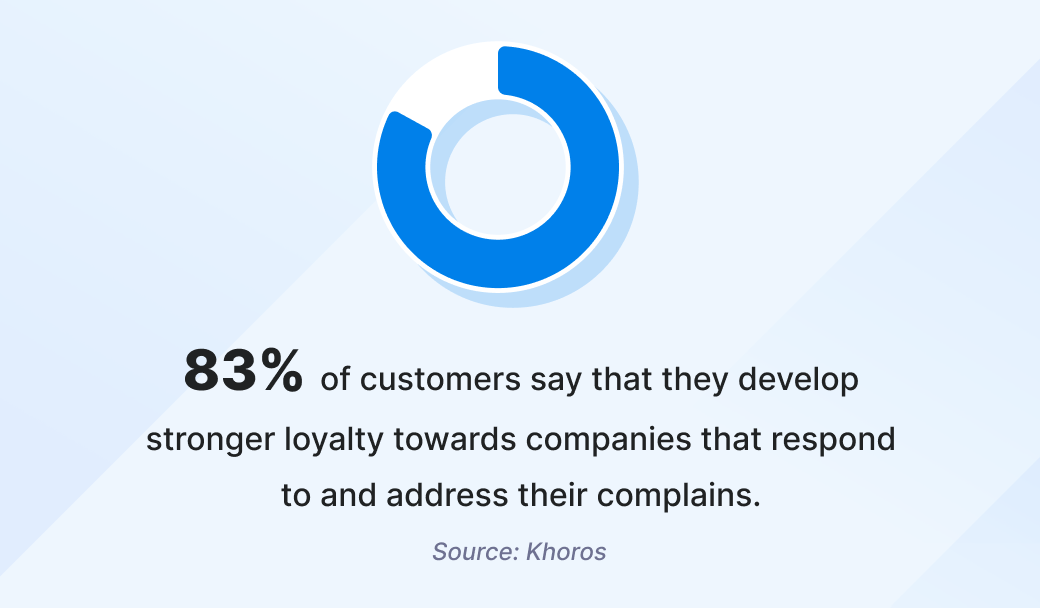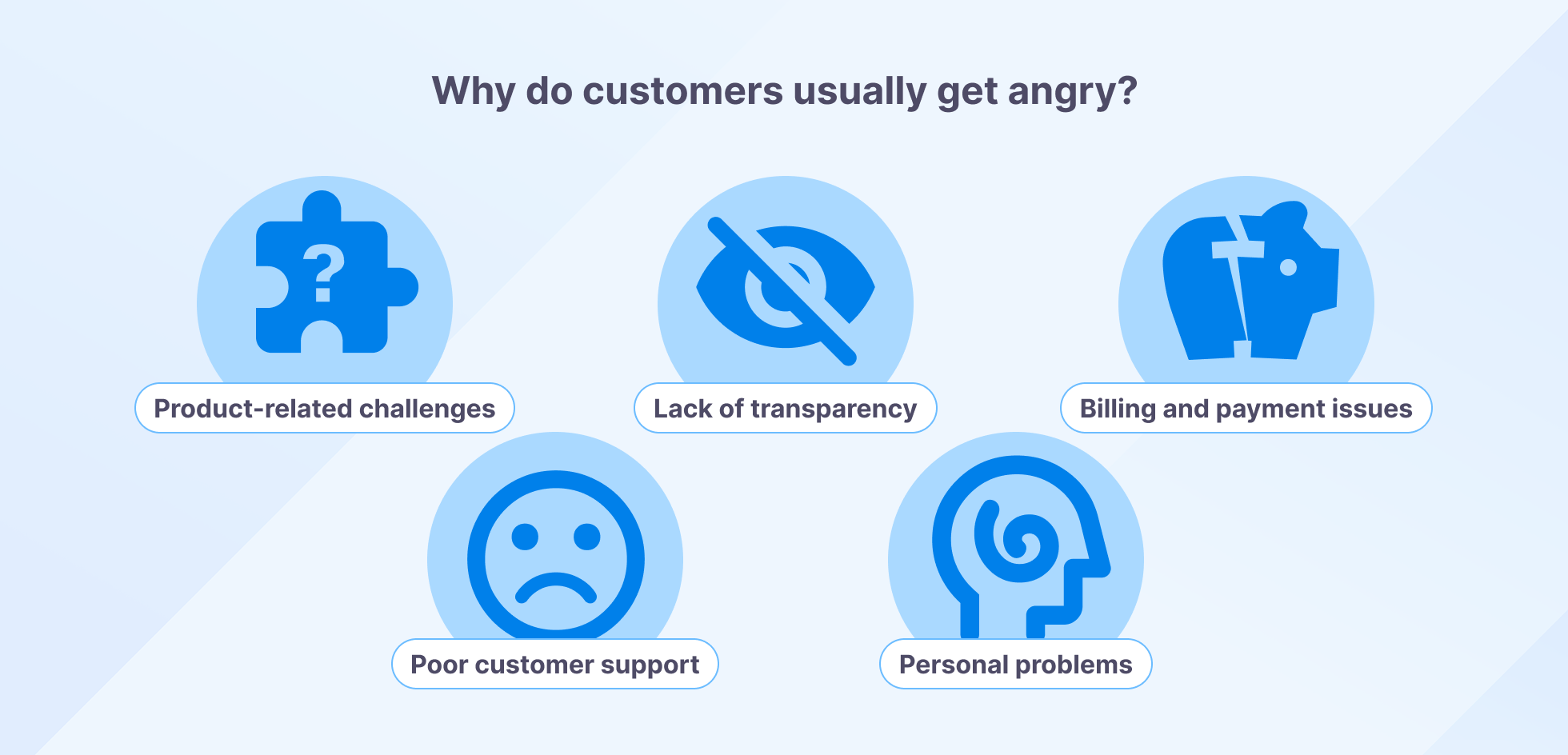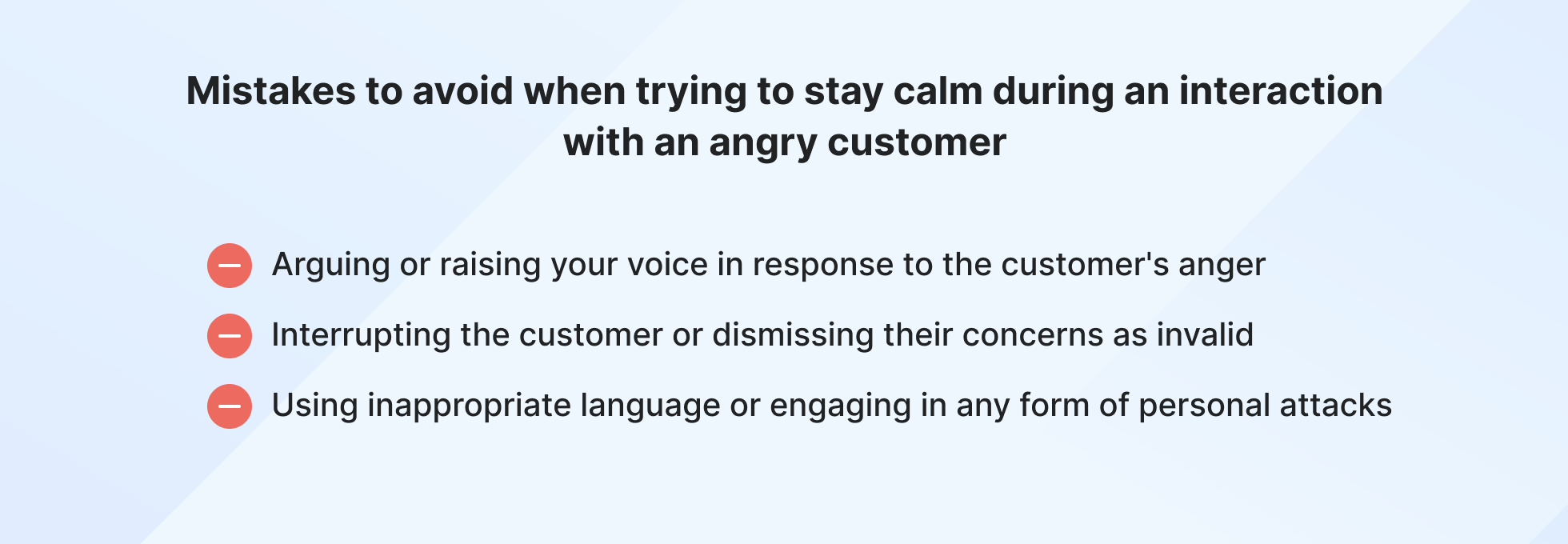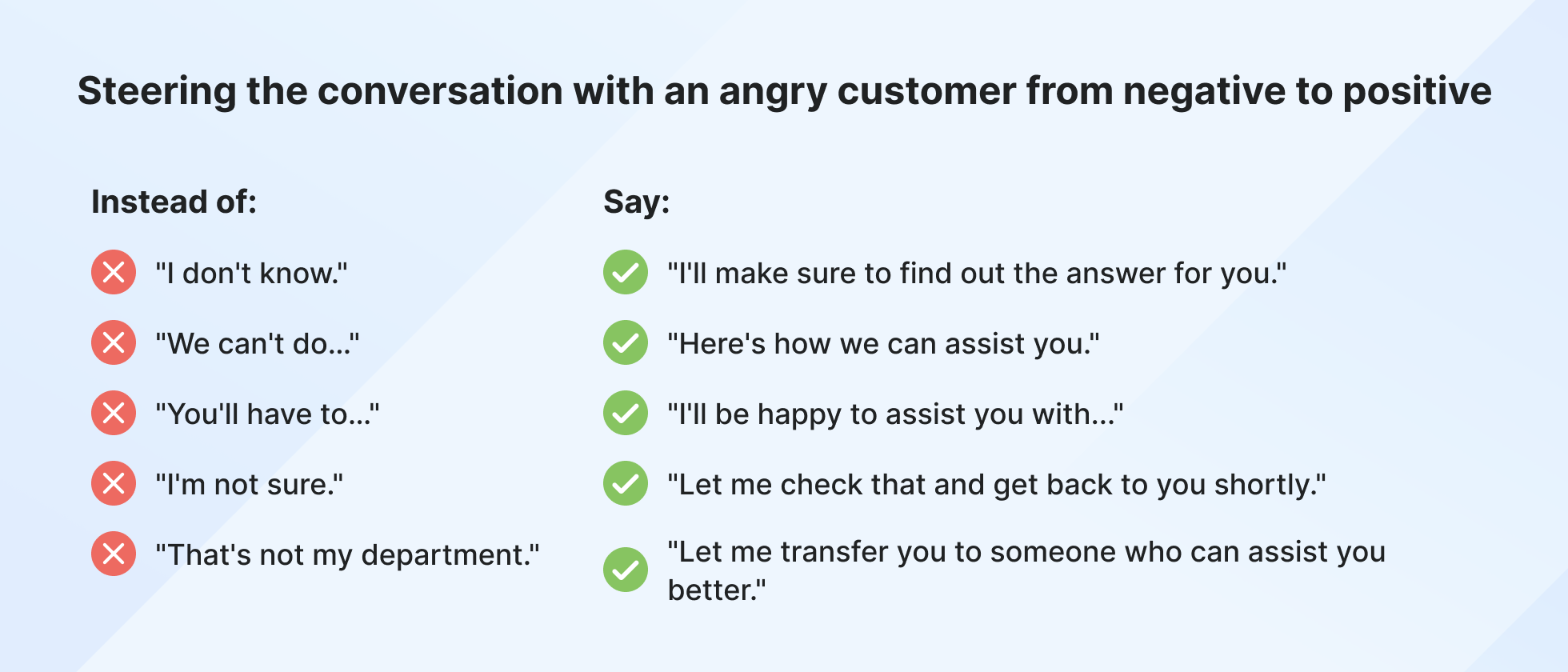
Knowing how to deal with angry customers is crucial for any business aiming to cultivate a positive brand reputation and prevent customer churn. According to a 2024 Khoros survey, 83% of customers say that they develop stronger loyalty towards companies that respond to and address their complaints.

Effective solutions to challenging customer interactions lead to positive feedback and top-star ratings. This blog post will equip you with ten invaluable tips and useful scripts to help you professionally navigate tough customer interactions.
So, let’s dive in and learn how to turn angry customers into satisfied and loyal advocates of your business.
Why do customers usually get angry?
Understanding your customers’ anger triggers can help you resolve their problems faster and improve their mood.
Let’s explore some common situations that make customers angry.
- Product-related challenges: When customers face issues with your product’s functionalities, performance, or reliability, it can cause frustration and hinder their business operations.
- Poor customer support: When customers seek help from the support team but receive unresponsive or unhelpful service, it can lead to anger.
- Lack of transparency: When companies are not transparent about their practices, pricing, or service changes, it can erode customer trust.
- Personal problems: Customers can get angry when personal problems compound with frustrations caused by a product or service. This creates a domino effect of heightened emotions, whereby even minor issues can trigger strong reactions.
- Billing and payment issues: Issues related to billing, such as incorrect charges, overcharging, or problems with refunds, can quickly escalate customer frustration.

Angry customers are actually good for business
It’s completely normal for customers to feel irate at times. However, there are effective ways to handle their anger. You can use their anger to negotiate and provide the best possible solutions. This, in turn, can strengthen their relationship with your business.
Dealing with unhappy customers is undeniably challenging, but irate customers can ultimately benefit your business despite the headaches they may bring. They are a great opportunity to gain valuable feedback from their perspective.
Use feedback resulting from interactions with angry customers to improve products or services, identify areas for process enhancement, and provide better experiences. Here’s how you can benefit from these interactions, according to Svitlana Fomenko, marketing specialist at CloudTalk:
“Angry customers are often the most honest ones. Their frustration highlights gaps in your service, offering you a valuable chance to proactively address weaknesses and build stronger customer loyalty.”
Ten tips on how to deal with angry customers
Dealing with angry customers can be a demanding aspect of delivering excellent customer service. At the same time, it’s an opportunity to turn a negative experience into a positive one. Here are ten valuable tips to help you navigate these tough encounters and leave your customers feeling heard, understood, and satisfied.
1. Maintain a calm presence
Staying calm when dealing with angry customers is crucial for maintaining a positive interaction and finding efficient outcomes to their concerns. It allows you to listen and respond thoughtfully. It also builds trust and confidence in the customer, who knows that they are being heard and respected.
To remain calm, customer service agents should:
- Remind themselves not to take the customer’s anger personally
- Take deep breaths and practice mindfulness to ground themselves
- Offer apologies and take responsibility for any mistakes on the company’s part
- Seek support from a supervisor or colleague if the situation becomes overwhelming

2. Personalize the interaction
When the situation is tough and things are getting stressful, it is important to personalize the interaction with the angry customer as much as possible.
Try using the customer’s name and introducing yourself — it can work wonders. It’s like making a real human connection instead of being anonymous voices on the phone or screen.
Here are two examples of adding a personal touch to the interaction with an irate customer.
- Utilize data and context from your customer relationship management (CRM) system to start the conversation with relevant information. Acknowledge any previous interactions or concerns that they might have had, showing that you’ve taken the time to review their history and are committed to resolving any lingering issues.
- Show that you value their unique needs and preferences by providing tailored suggestions for their issue. Take the time to explain how these solutions cater to their needs, highlighting the benefits that they will experience.
3. Show empathy towards your customers’ emotions
Taking the time to understand the customer’s unique concerns and addressing them on an individual level can make them feel valued and heard. This personal touch builds trust and rapport.
Take a moment to validate your customer’s emotions. Use this opportunity to connect with them on a personal level.
Be open and transparent about the factors contributing to the issue. Providing this context helps your customers comprehend that everyone, including the customer service representative they may be upset with, is striving to do their best.
Here are two ways to acknowledge your customer’s emotions:
- Simply express that you understand the pain they’re going through
- Offer an apology or admit they are right if your company has made a mistake

4. Use positive language
Using negative language with an angry customer can fuel an already explosive situation. A positive approach, however, shows the customer that you’re eager to help and are determined to find a positive outcome together. Positive language steers the conversation toward a favorable resolution.
Here are helpful tips for using positive language when handling irate customers:
- Steer clear of language that dismisses or undermines customer concerns
- Embrace words like “absolutely” and “definitely” in place of “actually” or “unfortunately”

5. Practice active listening while exploring solutions
When handling angry customers, practicing active listening is a game-changer. Active listening helps to understand the underlying issues of customers’ frustration, paving the way for tailored and relevant solutions. This approach diffuses tension and creates a more positive and trusting interaction.
Let the customer express their feelings and experiences during the interaction. Support them throughout the resolution process. Avoid repeating information, as it may escalate the situation. Use a CRM or a customer service platform to have all interaction history in one place and be able to handle negative feedback at any given moment.
Practice active listening by using phrases like “I see” or “of course” to show that you’re attentive. Mirror their language and acknowledge their emotions.
Even if a customer demands a refund and it’s impossible, communicate with your teammates to explore alternative solutions that may satisfy the customer.

6. Establish trust and express gratitude
When dealing with an angry customer, rebuilding any lost trust caused by a negative experience is key. Taking responsibility and being honest demonstrates your commitment to resolving their issue.
Thanking the customer for bringing the problem to your attention shows appreciation for their input and makes them feel valued.
📚 Consider reading some customer service books to refine your approach to re-establishing customer relationships. They will help you to stay updated on the latest customer service trends.
7. Shift to the right channel
Embrace omnichannel support to assist angry customers effectively. By employing various contact channels, such as email, chat, phone, or social media, you can provide a more consistent experience for an angry customer.
Switch channels when necessary. If a social media or text conversation becomes heated, consider shifting it to a phone call. Similarly, use video calls to troubleshoot issues and share screens. Video communication enables body language analysis and involves more human interactions.

8. Outline the upcoming course of action
When you can’t immediately resolve a customer’s problem, it is essential to outline your team’s steps to address it. This helps reduce the customer’s frustration and imparts a sense of trust in the company’s objective of finding a resolution.
Guide the customers through a roadmap of your problem-solving process, which includes:
- Immediate actions you’ll take
- Subsequent steps in the resolution process
- The expected timeframe for follow-up or final resolution
📋 Inform your customers about the next steps to set their expectations. This way, they won’t need to call for updates constantly. Clear communication of the process prevents escalations and eases pressure on your team.
9. Reach out for help
Managers can conduct investigations and resolve issues differently. Their expertise and fresh perspective may uncover insights or solutions that might have been otherwise overlooked. Involving more qualified personnel in the issue-resolution process demonstrates a commitment to providing the best possible outcome.
Don’t hesitate to seek help from higher management during tough situations. Your manager can assess the situation and determine the best way to deal with angry customers.
Here are some instances of when to ask for help.
- When a customer uses abusive or inappropriate language, involve a manager to help you handle the situation.
- When a customer angrily complains that the billing department made an error or there are complex account-related matters, consult your finance or account management team for guidance.
Marc Hardgrove, CEO at The HOTH, describes the optimal way to escalate customer issues:
“Handling upset customers requires customer service agents who can use a reasonable level of judgment. Company policies are a necessary guideline, but there are always cases where rigid compliance can be harmful. It is essential that you enable your team to identify these exceptions and make the necessary adjustments or create a clear channel through which a case gets to you for escalation. When exceptions become the norm, it is time to evaluate your policies.
Of course, empathy and a genuine will to help are good merits, but they must be accompanied by actions that people can actually take. No amount of empty promises will prevent the customer who thinks they have been taken advantage of from being angry. Remember — it is not about the money but a customer-centric approach, where your team really listens to them and tries to resolve those issues in a way that is acceptable to both parties.”
10. Consider hanging up as a last resort
When you involve a manager, they have the opportunity to assist you with exploring all available options. This also ensures that they are aware of your efforts to resolve the situation.
However, if a customer continuously contacts your team in a harassing manner, investing significant time and resources with mean customers might not be practical. Addressing prolonged customer issues can be resource-intensive and exceed the customer’s value to the company.
Hanging up becomes an appropriate course of action under the following circumstances:
- The customer resorts to personal insults and physical threats
- The customer persists in yelling or using inappropriate language despite efforts to address their concerns
Examples of how to deal with angry customers
In this section, we will provide some valuable templates on how to respond to someone venting. They provide guidance and suggestions on how to deal with angry customers on some of the most utilized customer communication channels.
How to respond over live chat
Handling an angry customer through chat can be stressful. Impatient customers may not tolerate delays in your responses. Prepare proactive live chat scripts to alleviate tension and smoothly navigate the conversation.
Templates to deal with angry customers over live chat







How to respond over the phone
Effective communication and empathy are essential when dealing with an angry customer over the phone. These scripts can help agents navigate challenging conversations and work toward a satisfactory resolution.
Script examples of angry customer situations over the phone
How to respond via email
Email communication is vital in addressing concerns and providing support. These email templates will help you create empathetic responses to different customer situations.
1. Email template to address the customer’s concerns
Subject line: Resolving your concerns
2. Apology email template
Subject line: An apology for any inconvenience you’ve encountered
3. Customer support follow-up email template
Subject line: Dedicated support and continuous improvement
How to reply on social media
Engaging with upset customers on social media demands tact and thoughtfulness. Provide personalized responses as part of your social media support approach.
Templates for replying to angry customer comments







How do you deal with an angry customer?
Converting negative experiences into positive ones when dealing with angry customers is an integral part of building strong customer relationships.
Handling an angry customer like a pro is not just a skill — it’s an art. Prioritize empathy, active listening, and effective problem-solving, and you will leave a lasting, positive impact on your customers.
Related articles
6 Proven sales funnel templates to accelerate your growth
Discover the top sales funnel templates that will h...
What is a text blast and how to send one
When you need to get a message out quickly to a larg...
How Banks & Financial Services Can Benefit from Bulk SMS Provider
Mobile has become one of the most personal communica...
How to recover deleted text messages: Essential tips and tools
There are plenty of ways to lose an important text f...
SMS solutions for transport & logistics companies
The field of transport and logistics is constantly e...



